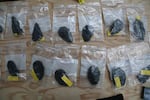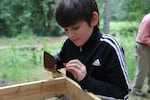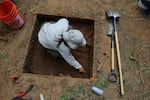Sometime deep in the past, 1,000 years ago or more, a member of the Santiam band of the Kalapuya people stopped on small hill near the Willamette River.

The 14 original obsidian bifaces found in the cache. Archeologists later found a fifteenth obsidian biface and several other stone tools on the site.
Amelia Templeton / OPB
He lingered by a spring under the shade of oak trees. When he moved on, for reasons that remain mysterious, he left behind a cache of at least 14 stone tools, each one about the size of a person’s palm.
Years passed. Layers of dirt and tree roots covered the tools. Settlers came. Someone built a house on the hillside under the oak trees. A thicket of blackberries 10 feet tall grew over the site.
And then, a middle school teacher named David bought the house on the little hill.
He didn't know that native Americans had once lingered on that same piece of ground. David just knew the yard was a mess, chocked with weeds and blackberry bushes. So he borrowed a neighbor's tractor and got to work.
Related: Oregon Archaeologists Discover 15,000-Year-Old Knife
It was the heat of summer, but underneath the weeds the ground was wet.
“I was like 'Oh, this is actually a spring. Cool,'” he said. So he got a shovel, to dig out the spring. He figured he could use it to water his vegetable garden.
“The next day I dig and a find this black obsidian stone. I thought, that’s a neat rock. I kind of tossed it aside, and kept digging,” he said.
David teaches math and science. He's young, and like any good science teacher, he's energetic and curious. We're just using David's first name because archaeological sites can attract unwanted visitors.
He found another piece of obsidian, and then another. Fourteen stones in all, each shaped like a very rough spear point.
David wasn't sure exactly what he'd discovered. So he took some pictures with his phone, and sent them to John Pouley, a state archeologist.
"I'm still amazed that he did that," said Pouley.
Most landowners don’t report finding Native American artifacts. They’re afraid their land will get taken away, a persistent myth in Oregon's rural communities.

Julius Samiee, one of David's students, examines the dirt archeologists are sifting through for clues to the origin of the bifaces.
Amelia Templeton / OPB
"There are archaeological sites in plowed fields. We don’t tell farmers that they can’t make a living," Pouley said. “We’re not going to take people’s lands. What we want to do is help inform the landowners.”
By law, artifacts found on private land belong to the landowner. There are exceptions: human remains and religious objects. If you’re deliberately searching for artifacts, you need a permit before you dig.
David had stumbled upon something exciting. A cache of stone tools, called bifaces. With a little work, a biface could be converted into a scraper, a spearpoint, or an arrowhead.
"Then you could also remove little flakes to have a sharp cutting edge to skin an animal, that you know were going to eat for dinner," Pouley said.
For thousands of years, Native Americans traveled to special quarries in the Cascade Mountains to make obsidian tools. Now, archeologists are using the special qualities of obsidian to map what trade routes in the Pacific Northwest looked like thousands of years ago.
Pouley’s best guess is that the cache David found is between 1,000 and 4,000 years old, and that it belonged to the Santiam band of the Kalapuya.
Today, the Kalapuya are part of the Grand Ronde. The tribe thanked David for reporting his discovery. They're making replicas of the bifaces with a 3-D printer.
Earlier this summer, Pouley brought a team to David’s property to do a formal excavation. Biface caches are relatively rare in the Willamette Valley, and he hoped to find more clues.
In June, workers excavated two pits near the spot where David found the first 14 tools.

A field worker carefully excavates a pit near the spot where an Oregon landowner discovered a cache of 14 obsidian tools.
Amelia Templeton / OPB
A woman fills a dust pan with dirt, and then hands it to a colleague who starts sifting. They're searching for tiny clues, like seeds or ancient charcoal, that could tell them about the person who left the tools behind.
They found a fifteenth obsidian biface and several more stone tools on the site.
Some of David's math students came to watch the excavation.
Pouley shared what he had learned so far with the kids. The tools found on David's property come from a prehistoric quarry 80 miles away, high in the Cascade Mountains, a site called Obsidian Cliffs. "Somebody went to the trouble to make these along ways away," he said.
Obsidian forms during volcanic eruptions. It picks up trace chemicals as it forms. When archeologists find stone tools, they can analyze those trace chemicals and reveal which obsidian flow the tool originally came from. That shows them how far the tool traveled after it was made. It's like having a tracking device.
Pouley pointed out another clue. The bifaces don't have any flakes missing. He suspects that the person who carried them down from the quarry wasn't planning to use them. He thinks that person might have been a traveling obsidian salesman.
"It seems likely that this was part of a trade network and these themselves were commodities," he said.
Obsidian tools were just one of many specialty items tribes manufactured and traded. For example, the Willamette Valley used to be thick with bright blue camas flowers. The Kalapuya people harvested tons of camas bulbs and baked them into cakes, which they traded with other tribes. The cakes were sweet and could keep for up to a year.
Most of those trade goods were eaten or decomposed, not left behind for archeologists. But the obsidian has lasted.
“So these bifaces, these obsidian tools are kind of an indicator item for this really broad trading network that was operating throughout the Pacific Northwest,” said Thomas Connolly, a University of Oregon archeologist who has mapped ancient trade routes by sourcing obsidian tools.
Here’s what the obsidian sourcing data shows: tools from the quarries in Oregon were traveling north. They were traded to native people in Washington, British Columbia, Alberta and Alaska.

Deputy state archeologist John Pouley holds one of the obsidian bifaces from the cache discovered in the Willamette Valley.
Amelia Templeton / OPB
The 14 stone tools David found in his backyard tell a piece of a story about large, prosperous tribes engaging in long distance trade for specialty items.
It’s a far different story than the one written by the white settlers who came to the Willamette Valley on the Oregon trail.
By then epidemics had killed virtually all the Kalapuya people. In just a few generations, about 95 percent of the native population in the Willamette Valley died.
“A lot of the recorded history captures that moment, and doesn’t reflect the true nature of those societies 100 years before the epidemics,” Connolly says.
On the hillside, the state’s archeology team continues its careful digging.
David’s students ponder the 14 stone tools their teacher found. Why did someone leave them thousands of years ago and never return?
“Maybe they dropped in value?”
“They could have been using them as a tool to fight, but they were abandoned in the fight.”
"I think there could have been a flood or something, so the native Americans couldn't find them."
And then one of the kids has a more practical question for Pouley.
"How much money would these bifaces be worth a piece?"
"I have no idea," he said. Their value is in what we can learn from them.
